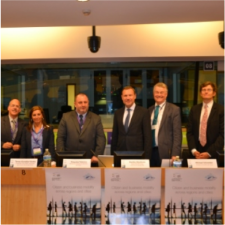This is a new approach to driving forward innovation in Europe; and the ideas themselves have been created in a more open and participative way than is usual, delivering in direct consequence better ideas, faster and at lower cost.
[Text adopted from the European Commission’s Digital Agenda for Europe website: http://ec.europa.eu/digital-agenda/]: Report/Study: 06/06/2013: https://ec.europa.eu/digital-agenda/node/66731
Marking the successful conclusion of the Open Innovation 2.0 Conference held at Dublin Castle the EU Open Innovation Strategy and Policy Group (OISPG) have released a paper entitled ‘Open Innovation 2.0 – A New Paradigm’ which outlines the key emerging characteristics and practices of Open Innovation 2.0 (OI2) and how it can practically help address key European challenges.
Marking the successful conclusion of the Open Innovation 2.0 Conference held at Dublin Castle the EU Open Innovation Strategy and Policy Group (OISPG) have released a paper entitled ‘Open Innovation 2.0 – A New Paradigm’ which outlines the key emerging characteristics and practices of Open Innovation 2.0 (OI2) and how it can practically help address key European challenges.
The OI2 paper and the Dublin Innovation Declaration were the key outputs from the Open Innovation 2.0 Conference co-organized by the OISPG, Intel Labs Europe, The European Commission – DG Communications Networks, Media and Technology (DG CONNECT), Dublin City and Trinity College Dublin. The OI2 paper outlines key emerging characteristics of the new Open Innovation 2.0 paradigm whilst the Declaration outlines 10 key actions to advance progress in the EU towards achieving the Europe 2020 goals of smart, inclusive and sustainable growth.
Releasing the OI2 paper, Prof Martin Curley, Vice President of Intel and Chair of the EU OISPG said “We now have a framework and action items which can help catalyse a European recovery through Innovation- the new Open Innovation 2.0 paradigm shines a strong beacon of light towards our collective better future”.
Welcoming the publication of the OI2 paper and the Dublin Innovation Declaration, Director General of DG CONNECT Robert Madelin said ”This is a new approach to driving forward innovation in Europe; and the ideas themselves have been created in a more open and participative way than is usual, delivering in direct consequence better ideas, faster and at lower cost. As Commissioner Neelie Kroes has made clear in the past year, innovation needs a deeper embrace of riskier policies by public leaders: with this Dublin event, we have some of the tools we need to do just that”.
Addressing the Dublin Digital Leadership Forum Dublin on Tuesday June 4 Lord Mayor Naoise O’Muiri affirmed the Dublin Innovation Declaration saying “Dublin is committed to the principles embedded in the Dublin Innovation Declaration and we are using Open Innovation 2.0 as a core vehicle for co-creating the future of Dublin”.
Open Innovation 2.0 Conference and The Dublin Innovation Declaration:
The Dublin Innovation Declaration was co-created at the Open Innovation 2.0 Conference and it was overwhelmingly ratified and endorsed through vote by participants during the concluding session of the two day international conference. The Declaration was formed as the challenges faced in Europe and beyond are too large to tackle in isolation and thus a new approach to innovation is required. Better solutions are needed globally in domains such as healthcare, transportation, climate change, youth unemployment, financial stability, prosperity, sustainability, and growth. These challenges provide a significant opportunity to create new shared value through innovation. Society’s challenges may well reflect the transition to innovative solutions and today’s challenges are perhaps best seen as examples of Joseph Schumpeter’s creative destruction model where the failure of old approaches fuels the motivation for change and shapes the future. The challenges also call attention to the quadruple helix model of innovation where civil society joins with business, academia, and government sectors to drive changes far beyond the scope of what any one organization can do on their own.
Irish Minister for Research and Innovation, Seán Sherlock TD said: “We welcome the fact that this seminal conference took place in Ireland and during the Irish Presidency of the Council of the EU. I believe many of the actions identified in the declaration have merit and hold promise in terms of their potential to further strengthen our Innovation eco-system within the EU – to the extent that they are not already being addressed, I think many of these actions deserve active consideration by the EU ”.
Bror Salmelin, Advisor for Innovation systems in DG CONNECT said: “Open Innovation 2.0 brings together the strengths of Europe in a new way, to increase seamless co-creation of innovative products and services to match the challenges we see in our economy and society“.
Related Documents:
OISPG Open Innovation 2.0 A New Paradigm – White Paper


